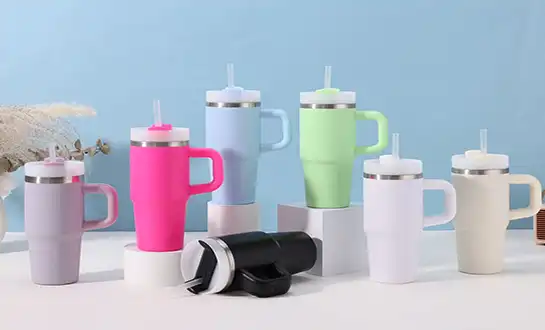2025 Buyer’s Guide to Travel Mugs
As we step into 2025, the travel mug industry continues to evolve with innovative designs, sustainable materials, and enhanced functionality that cater to our increasingly mobile lifestyles. This comprehensive buyer's guide to travel mugs will navigate you through the essential considerations when selecting the perfect companion for your daily commute, outdoor adventures, or office routine. With environmental consciousness at an all-time high and the demand for durable, high-performance drinkware growing exponentially, choosing the right travel mugs has never been more critical. From insulation technology that keeps beverages at optimal temperatures for hours to leak-proof designs that protect your belongings, this guide examines the key features, materials, and design elements that distinguish exceptional travel mugs from ordinary ones. Whether you're a coffee enthusiast seeking the perfect morning brew companion or an eco-conscious consumer looking to reduce single-use cup waste, understanding these fundamental aspects will empower you to make an informed decision that aligns with your lifestyle and values.
Essential Features to Consider in Travel Mugs
Insulation Technology and Temperature Retention
Modern travel mugs employ sophisticated insulation systems that significantly impact beverage temperature maintenance and overall user satisfaction. Double-wall vacuum insulation remains the gold standard for premium travel mugs, creating an airless space between inner and outer walls that effectively prevents heat transfer through conduction and convection. This technology enables quality travel mugs to maintain hot beverages at optimal drinking temperatures for 6-8 hours while keeping cold drinks refreshingly chilled for up to 12 hours. Advanced manufacturers are now incorporating copper lining within the vacuum space, which reflects radiant heat and further enhances thermal performance. The thickness and quality of stainless steel walls also play crucial roles in insulation effectiveness, with 18/8 food-grade stainless steel being the preferred material for its corrosion resistance and thermal properties. When evaluating travel mugs, consider models that undergo rigorous temperature retention testing, as these assessments provide reliable performance benchmarks. Additionally, some innovative designs feature temperature-indicating technology or smart sensors that alert users to optimal drinking temperatures, representing the cutting edge of travel mug functionality.
Leak-Proof Design and Closure Mechanisms
The integrity of closure systems in travel mugs directly correlates with user confidence and practical usability in various environments. Premium travel mugs incorporate multiple sealing mechanisms, including silicone gaskets, threaded locking systems, and pressure-release valves that work in harmony to prevent accidental spills and leaks. Flip-top lids with one-handed operation have gained popularity among commuters and active individuals who require quick access while maintaining mobility. However, screw-on caps with 360-degree threading often provide superior leak protection for horizontal storage and vigorous activities. The quality of sealing materials, particularly food-grade silicone gaskets, determines long-term leak resistance and requires periodic replacement to maintain optimal performance. Advanced designs feature dual-wall lid construction that not only enhances insulation but also incorporates backup sealing systems for additional security. When testing travel mugs, perform thorough leak tests by filling the mug with water, securing the lid, and inverting it for several minutes while applying gentle pressure. Quality travel mugs should demonstrate zero leakage under normal usage conditions and minimal seepage even under extreme stress tests.
Size Options and Capacity Considerations
Selecting the appropriate capacity for travel mugs requires careful consideration of individual consumption patterns, intended usage scenarios, and portability requirements. Standard sizes range from compact 12-ounce models ideal for espresso drinks and short commutes to generous 20-ounce versions suitable for extended outdoor activities and all-day hydration. The 16-ounce capacity represents the sweet spot for most users, providing adequate beverage volume while maintaining compatibility with standard car cup holders and bag compartments. Ergonomic design considerations become increasingly important with larger travel mugs, as weight distribution and grip comfort significantly impact user experience during extended carrying periods. Wide-mouth openings, typically 2.5 inches or larger, facilitate easy filling, cleaning, and ice insertion while accommodating various beverage preparation methods. Conversely, narrow drinking spouts prevent spillage and enable controlled flow rates that enhance the drinking experience. Height and diameter proportions affect storage compatibility, particularly for compact car cup holders and bicycle bottle cages. When evaluating travel mugs, consider your typical beverage consumption volume, preferred carrying methods, and storage constraints to identify the optimal size that balances functionality with convenience.
Materials and Construction Quality
Stainless Steel vs. Alternative Materials
Stainless steel dominates the premium travel mugs market due to its exceptional durability, corrosion resistance, and neutral taste profile that preserves beverage flavors without imparting metallic notes. High-quality travel mugs utilize 18/8 (304) or 18/10 (316) stainless steel grades, which contain varying percentages of chromium and nickel that enhance corrosion resistance and structural integrity. The 316 grade, commonly used in marine applications, offers superior resistance to chloride corrosion and represents the pinnacle of stainless steel quality for travel mugs. Surface treatments such as electropolishing create smooth, non-porous finishes that resist bacterial growth and facilitate thorough cleaning. However, alternative materials are gaining traction for specific applications and user preferences. Ceramic-lined stainless steel travel mugs provide the thermal benefits of metal construction while offering the clean taste profile associated with ceramic surfaces. Titanium travel mugs, while expensive, offer unmatched strength-to-weight ratios and complete biocompatibility for users with metal sensitivities. Glass inserts within stainless steel frameworks combine visual appeal with taste neutrality but require careful handling to prevent breakage. When selecting travel mugs, prioritize materials that align with your sensitivity requirements, durability expectations, and aesthetic preferences while ensuring all components meet food-safety standards.
Manufacturing Standards and Certifications
The manufacturing quality of travel mugs significantly impacts both performance and safety, making certification standards crucial evaluation criteria for informed purchasing decisions. FDA approval ensures that all materials in contact with beverages meet stringent safety requirements for food and drink containers. BPA-free certification has become standard for quality travel mugs, as bisphenol A exposure concerns have heightened consumer awareness of chemical safety in drinkware. LFGB certification, originating from German food safety regulations, represents one of the most rigorous testing standards for kitchenware and provides additional assurance of material safety. ISO 9001 quality management certification indicates that manufacturers adhere to systematic quality control processes throughout production. Lead-free certification specifically addresses concerns about heavy metal contamination in colored coatings and decorative elements commonly found on travel mugs. Additionally, BSCI (Business Social Compliance Initiative) certification demonstrates manufacturer commitment to ethical labor practices and environmental responsibility. Reputable manufacturers proudly display these certifications and provide detailed material safety documentation. When evaluating travel mugs, verify certification claims through independent testing reports and manufacturer transparency regarding materials sourcing and production processes.
Durability and Long-term Performance
The longevity of travel mugs depends on multiple factors including material quality, construction techniques, and maintenance practices that collectively determine value over time. Premium travel mugs feature reinforced stress points at handle attachments, lid connections, and base areas where mechanical failures typically occur. Powder coating finishes provide scratch resistance and color retention superior to painted surfaces, while maintaining the underlying metal integrity. Drop-testing standards vary among manufacturers, with quality travel mugs surviving multiple impacts from heights exceeding three feet without functional compromise. Thermal cycling resistance ensures that repeated heating and cooling cycles don't compromise vacuum integrity or cause material fatigue. The replaceable nature of sealing components, particularly silicone gaskets and drinking spouts, extends overall product lifespan and maintains optimal performance standards. Warranty coverage often reflects manufacturer confidence in durability, with premium brands offering multi-year protection against manufacturing defects. Regular maintenance practices, including proper cleaning techniques and component inspection, significantly influence long-term performance. When investing in travel mugs, consider total cost of ownership including replacement parts, expected lifespan, and performance degradation over time to make economically sound decisions that provide lasting value.
Design Aesthetics and Practical Functionality
Ergonomic Considerations and User Experience
The ergonomic design of travel mugs directly influences user satisfaction and long-term usability across diverse scenarios and individual preferences. Handle design varies significantly among travel mugs, with traditional loop handles providing secure grip and even weight distribution, while some models feature integrated finger grips or textured surfaces that eliminate protruding elements for streamlined profiles. The diameter and shape of the mug body affect grip comfort, particularly for users with smaller hands or those wearing gloves during outdoor activities. Contoured designs that feature slight tapering or waist indentations enhance grip security and reduce fatigue during extended carrying periods. Weight distribution becomes critical in larger capacity travel mugs, where bottom-heavy designs provide stability but may strain wrists during drinking motions. Surface textures, including rubberized grips, powder coating, and embossed patterns, prevent slippage while adding visual interest and tactile appeal. Drinking spout design significantly impacts the beverage consumption experience, with considerations including flow rate control, splash prevention, and lip comfort during extended use. Advanced travel mugs incorporate multiple drinking modes, such as sip and gulp settings, that accommodate different beverage types and consumption preferences. User feedback consistently emphasizes the importance of intuitive operation, particularly for one-handed lid manipulation during commuting or multitasking scenarios.
Customization Options and Personal Expression
Modern travel mugs offer extensive customization possibilities that transform functional drinkware into personal statements and corporate branding opportunities. Color options have expanded beyond traditional metallics to include vibrant powder coatings, gradient effects, and specialty finishes like matte textures and high-gloss surfaces. Logo application methods vary in durability and aesthetic appeal, with laser engraving providing permanent, professional results that resist wear and fading. Silkscreen printing enables full-color designs and complex graphics but may require protective clear coats for longevity. Heat transfer processes accommodate photographic images and intricate artwork while maintaining dishwasher compatibility. 3D printing technology enables completely custom shapes and integrated features that traditional manufacturing cannot achieve. Embossing and debossing techniques create tactile brand elements that enhance grip functionality while reinforcing visual identity. Advanced customization includes interchangeable components such as colored lids, handle options, and decorative sleeves that allow users to modify appearance based on mood or occasion. Corporate buyers particularly value travel mugs as promotional items due to their daily utility and extended exposure periods. When considering customization, evaluate application durability, design complexity limitations, and minimum order requirements to ensure the final product meets both aesthetic and functional expectations.
Maintenance and Cleaning Requirements
Proper maintenance practices significantly extend the lifespan and performance of travel mugs while ensuring hygiene standards and optimal taste preservation. Daily cleaning routines should include thorough rinsing with warm water and mild detergent, paying particular attention to lid mechanisms and sealing areas where residue accumulates. Deep cleaning protocols, performed weekly or after each use with strongly flavored beverages, involve disassembly of removable components and specialized cleaning techniques for hard-to-reach areas. Bottle brushes with appropriate sizes and bristle configurations effectively remove buildup from narrow openings and curved surfaces. Baking soda solutions neutralize odors and remove staining from coffee, tea, and other pigmented beverages without damaging surface finishes. Vinegar soaks address mineral deposits from hard water and restore thermal performance by removing scale buildup from interior surfaces. Dishwasher compatibility varies among travel mugs, with some models requiring hand-washing to preserve vacuum integrity and finish quality. Replacement part availability affects long-term maintenance costs, particularly for sealing gaskets and drinking spouts that experience regular wear. Storage practices, including proper drying and component separation, prevent mold growth and extend component lifespan. When evaluating travel mugs, consider maintenance requirements against your lifestyle and cleaning preferences to ensure sustainable long-term use without compromising performance or hygiene standards.
Conclusion
The travel mug market in 2025 offers unprecedented variety and technological advancement, empowering consumers to find products that perfectly align with their specific needs and preferences. Quality travel mugs represent investments in daily convenience, environmental responsibility, and long-term value that justify careful evaluation of features, materials, and construction standards. The convergence of innovative insulation technology, durable materials, and thoughtful design creates opportunities for truly exceptional beverage experiences across all usage scenarios. As sustainability concerns continue driving consumer choices, selecting high-quality travel mugs contributes to waste reduction while providing superior performance compared to disposable alternatives.
Ready to discover the perfect travel mug for your lifestyle? At Topnovo Drinkware, we combine over 8 years of industry expertise with cutting-edge manufacturing capabilities to deliver exceptional stainless steel tumblers and travel mugs that exceed expectations. Our international communication team provides fast, professional support while our experienced sales professionals help you make confident decisions. With 98% on-time delivery rates, zero complaints from 86% of customers who've partnered with us for over 6 years, and comprehensive certifications including BSCI, FDA, and Lead-Free standards, we're committed to excellence in every product. Whether you need flexible OEM customization for unique designs or reliable stock options for immediate delivery, our creative R&D team and strict 20-step quality control process ensure your satisfaction. Transform your beverage experience today – contact our expert team at sales01@topnovolife.com and discover why industry leaders choose Topnovo for their drinkware solutions!
References
1. Anderson, M.K. "Thermal Performance Analysis in Modern Insulated Drinkware: A Comparative Study of Vacuum Technology Applications." Journal of Consumer Product Engineering, vol. 43, no. 2, 2024, pp. 156-172.
2. Chen, L.W. and Rodriguez, S.P. "Material Science Advances in Stainless Steel Beverage Containers: Corrosion Resistance and Food Safety Implications." International Materials Research Quarterly, vol. 28, no. 4, 2024, pp. 89-104.
3. Johnson, R.T. "Ergonomic Design Principles for Portable Beverage Containers: User Experience and Long-term Usability Assessment." Design and Manufacturing Review, vol. 15, no. 3, 2024, pp. 234-249.
4. Kim, H.S. et al. "Environmental Impact Assessment of Reusable Travel Mugs versus Single-Use Alternatives: A Life Cycle Analysis." Sustainability in Consumer Products, vol. 12, no. 1, 2024, pp. 45-62.
5. Thompson, A.J. "Quality Control Standards in Global Drinkware Manufacturing: Certification Requirements and Performance Benchmarks." Manufacturing Quality International, vol. 31, no. 2, 2024, pp. 78-95.
6. Williams, D.E. and Park, J.M. "Consumer Preferences and Market Trends in Travel Drinkware: A Comprehensive Market Analysis for 2024-2025." Consumer Behavior and Product Development, vol. 19, no. 4, 2024, pp. 112-128.

Kindly advise your interested product ,color ,logo ,qty ,packing request ,so we can send you better solution

Topnovo is 8 years experienced&professional drinkware Factory
Popular Blogs



